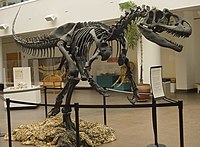Theropod fractures

Bruce Rothschild and others published a study examining evidence for stress fractures and tendon avulsions in theropod dinosaurs and the implications for their behavior.[1] These pathologies provide evidence for very active predation-based rather than scavenging diets.[1] Stress fractures are caused by repeated trauma rather than singular events like acute fractures.[2] Since stress fractures are due to repeated events they are probably caused by expressions of behavior.[3] Activity-related fractures are also known from ceratopsians.[3] Pedal injuries could be caused by runnning or migration, but manual injuries would most likely be due to resistant prey items.[3] Stress fractures in dinosaur bones can be identified by studying the bones for diaphyseal surface bulges, usually facing anteriorly on the bone. When viewed under x-rays the fractures exhibit areas of reduced x-ray attenuation that appear as a clear zone angled through the diaphyseal bulge.[4] Usually this zone of attenuation is not visible on the surface of the bone.[4] Allosaurus had a significantly greater number of diaphyeal bumps than Albertosaurus, Ornithomimus or Archaeornithomimus.[5] The fractures "were distributed to the proximal phalanges" and occurred across all three major digits in "statistically indistinguishable" numbers.[5] Pathologies of the distal unguals were only noted among dromaeosaurids, where they represented 50% of manual lesions.[6] The authors refrained from performing a statistical analysis of these injuries in non-dromaeosaur theropods because they were so uncommon that such an analysis would be impossible for all intents and purposes.[6]
Avulsion injuries were only noted among Tyrannosaurus and Allosaurus.[7] Scars from these sorts of injuries were limited to the humerus and scapula.[7] A divot on the humerus of Sue the T. rex was one such avulsion.[7] The divot appears to be located at the origin of the deltoid or teres major.[7] The researchers described theropod phalanges as being pathognomonic for stress fractures, meaning they are "characteristic and unequivocal diagnostically."[7] Lesions left by stress fractures can be distinguished from osteomyelitis without difficulty because of a lack of bone destruction.[7] They can be distinguished from benign bone tumors like osteoid osteoma by the lack of a sclerotic perimeter.[7] No disturbance of the internal bony architecture of the sort caused by malignant bone tumors was encountered among the stress fracture candidates.[7] No evidence of metabolic disorders like hyperparathyroidism or hyperthyroidism was found in the specimens.[7] The thin shell caused by a subperiosteal hematoma was not seen and would have been easily identified under x-ray.[7] Since the lower end of the third metatarsal would contacted the ground first while a theropod was running it would have borne the most stress and should be most predisposed to suffer stress factors.[7] The lack of such a bias in the examined fossils indicates an origin for the stress fractures from a source other than running.[7] The authors conclude that these fractures occurred during interaction with prey.[7] They suggest that such injuries could occur as a result of the theropod trying to hold struggling prey with its feet.[7] The localization in theropod scapulae as evidenced by the tendon avulsion in Sue suggests that theropods may have had a musculature more complex and functionally different than those of birds.[8] The authors suggest that future workers compare the anatomy of a Komodo dragon and crocodile with that of Tyrannosaurus.[8]
| Affected Taxon[9] | Affected Pedes[9] | Total Pedes Examined[9] | Affected Manus[9] | Total Manus Examined[9] | Affected Specimen[9] |
|---|---|---|---|---|---|
1 | 1 | 0 | 0 | Not listed. | |
17 | 281 | 3 | 47 | ||
1 | 319 | 0 | 4 | ||
1 | 81 | 0 | 10 | ||
Tyrannosauridae (indeterminate) | 3 | 105 | 1 | 5 | |
0 | 18 | 1 | 10 | ||
2 | 82 | 2 | 9 | ||
Dromaeosauridae (indeterminate) | 4 | 17 | 4 | 12 | |
Ornithomimidae (indeterminate) | 1 | 15 | 0 | 8 | Not listed. |
1 | 17 | 1 | 17 | RTMP 92.36.448. Note that the authors weren't sure if this was a pedal or manual specimen. | |
Theropoda (small, indeterminate) | 1 | 4 | 0 | 0 | Not listed. |
The following taxa had no evidence of stress fractures or tendon avulsions among the examined specimens: Herrerasaurus, Coelophysis, Dilophosaurus, Carnosaur (indeterminate), Velocisaurus, Mononykus, Megalosaurus, Marshosaurus, Ornitholestes, Compsognathus, Alectrosaurus, Albertosaur, Gorgosaurus, Utahraptor, Deinonychus, Therizinosauridae (indeterminate), Struthiomimus, Ornithomimus, Archaeornithomimus, Dromiceiomimus, Elmisaurus, and Troodon.[9]
Footnotes
Reference
- Rothschild, B., Tanke, D. H., and Ford, T. L., 2001, Theropod stress fractures and tendon avulsions as a clue to activity: In: Mesozoic Vertebrate Life, edited by Tanke, D. H., and Carpenter, K., Indiana University Press, p. 331-336.